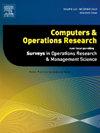集装箱装载问题的分块构造约束规划模型
IF 4.1
2区 工程技术
Q2 COMPUTER SCIENCE, INTERDISCIPLINARY APPLICATIONS
引用次数: 0
摘要
集装箱装载问题涉及到将一组给定的矩形箱子装入一个更大的固定尺寸的矩形集装箱中,目的是使装载的箱子的体积最大化。大多数关于集装箱装载问题及其变体的文献都提出了启发式方法,可以快速找到好的解决方案。目前的精确方法大多局限于混合整数规划(MIP)公式,这往往难以获得大型问题实例的良好解。本文引入了集装箱装载问题的两个精确约束规划模型。第一个模型使用整数和二进制变量将盒子分配到容器内的有效位置和方向。第二个模型通过结合通常用于启发式方法的块构建概念来增强这一点。在经典的经典基准实例上进行的大量计算实验表明,所提出的模型得到的解明显优于现有的MIP模型。我们还对提出的模型进行实例空间分析,以映射模型在问题实例中的性能,从而更深入地了解块构建方法的优缺点。本文章由计算机程序翻译,如有差异,请以英文原文为准。
A block-building constraint programming model for the container loading problem
The container loading problem involves packing a set of given rectangular boxes into a larger rectangular container of fixed size, with the objective of maximizing the volume of the loaded boxes. Most of the literature on the container loading problem and its variants proposes heuristic approaches that can find good solutions quickly. Current exact methods are mostly limited to mixed-integer programming (MIP) formulations, which often struggle to obtain good solutions for large problem instances.
In this paper, we introduce two exact constraint programming models for the container loading problem. The first model uses integer and binary variables to assign boxes to valid positions and orientations within the container. The second model enhances this by incorporating the concept of block-building, commonly used in heuristic methods. Extensive computational experiments on classical benchmark instances from the literature show that the solutions obtained with the proposed models significantly outperform those achieved with existing MIP models. We also perform an instance space analysis of the proposed models to map the models’ performances across problem instances, providing deeper insights into the strengths and weaknesses of the block-building approach.
求助全文
通过发布文献求助,成功后即可免费获取论文全文。
去求助
来源期刊

Computers & Operations Research
工程技术-工程:工业
CiteScore
8.60
自引率
8.70%
发文量
292
审稿时长
8.5 months
期刊介绍:
Operations research and computers meet in a large number of scientific fields, many of which are of vital current concern to our troubled society. These include, among others, ecology, transportation, safety, reliability, urban planning, economics, inventory control, investment strategy and logistics (including reverse logistics). Computers & Operations Research provides an international forum for the application of computers and operations research techniques to problems in these and related fields.
 求助内容:
求助内容: 应助结果提醒方式:
应助结果提醒方式:


